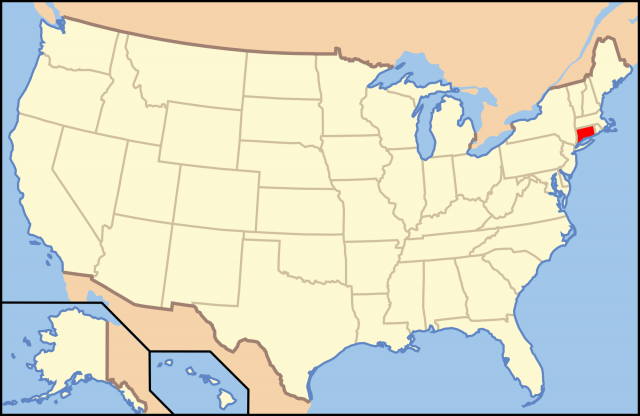The State of Connecticut
AT A GLANCE
Name: Connecticut comes from an Algonquian word meaning “place beside the long tidal river.”
Nicknames: Constitution State, Nutmeg State
Capital: Hartford
Size: 5,544 sq. mi.
Population: 3,597,000 (2014)
Statehood: Connecticut became the fifth state on January 9, 1788.
Electoral votes: 7 (2016)
U.S. Representatives: 6 (until 2016)
State tree: white oak
State flower: mountain laurel
State animal: sperm whale
Highest point: Mount Frissell, 2,380 ft.

THE PLACE
Connecticut is the third-smallest state and forms the southern portion of New England. Connecticut has rolling hills and mountains to the north and west and 250 miles of shoreline to the south along Long Island Sound. Elevations are highest in the northwest corner of the state.
Connecticut has many lakes, streams, and rivers. The Connecticut River flows south from upper New England, cuts through the middle of the state, and ends in Long although much of Connecticut's soil is too stony for farming.
Connecticut has a climate that does not range to great extremes. The state's weather is warm in the summer and cold and snowy in the winter. Connecticut's climate is milder than that of the more northerly New England states.
Connecticut does not have many natural resources, but forests are plentiful, and sand and gravel are important exports.
Facts and Firsts
- In 1728, the first American steel mill opened in Simsbury, Connecticut.
- Connecticut native Noah Webster wrote the first American dictionary, which was published in 1806.
- New Haven was the first place in the world to have a telephone exchange. The exchange opened on January 28, 1878. New Haven also had the first telephone book, which was published the same year the exchange opened and contained only 50 names.
- The oldest public library in the country is the Scoville Public Library, in Scoville.
- The hamburger (1895), Polaroid camera (1934), helicopter (1939), and color television (1948) were invented in Connecticut.
- The world's first nuclear-powered submarine, the USS Nautilus, was built in Groton in 1954.
- Pez candy is manufactured in Orange.
- In 1999, Connecticut was the state with the highest per capita income (money earned per person). In 2000, New Jersey surpassed it for the first time in many years.
THE PAST
Native American tribes that lived in the area for hundreds of years named the region.
The first Europeans to explore the territory were the Dutch. Settlers from the Massachusetts Bay Colony quickly followed. While still under British rule, Connecticut became the first state to create its own charter, the Fundamental Orders of 1639. This earned Connecticut one of its nicknames, the Constitution State.
Connecticut was one of the original thirteen colonies. The state played an important role in the American Revolution as a major supplier for the Continental army. After the war, Connecticut became a key industrial and manufacturing state. The state's strong rivers provided it with an inexpensive energy source for its many mills. When Connecticut's economy shifted from farming to manufacturing, demand for ready-to-wear clothing helped the textile industry to grow.
Connecticut residents also invented a number of useful products, including the portable typewriter and the can opener. Other significant items from Connecticut were the cotton gin, invented by Eli Whitney in 1794; the first sewing machine invented by Elias Howe in 1846; and the first artificial heart invented by Dr. Robert K. Jarvik in 1982.
Connecticut mills and factories were also known for their brass, clocks, silverware, locks, guns, and tools. Although the days of the old mills have passed, Connecticut remains a leading industrial state today.
THE PRESENT
Connecticut has retained a strong sense of history. The state offers a blend of urban and rural areas that include both large cities and small farming towns. The farms produce dairy foods, poultry, fruits, and vegetables. Tobacco is the state's most valuable crop.
Connecticut is home to many of the nation's insurance companies. Hartford is known as the Insurance Capital of the World. Other Connecticut cities produce weapons, helicopters, jet engines, and submarines.
Yale University, founded in 1701, is the third-oldest institution of higher learning in the United States. Its library is the oldest library still operating in Connecticut. Many people visit Connecticut every year to tour its historic small towns, fish and camp in Connecticut's rural areas, or take in the colorful foliage of a Connecticut autumn.
Born in Connecticut
- Dean Acheson, statesman
- Ethan Allen, American Revolutionary War soldier
- Benedict Arnold, American Revolutionary general
- (Phineas Taylor) P.T. Barnum, showman
- Henry Ward Beecher, clergyman
- John Brown, abolitionist
- George W. Bush, U.S. president
- Samuel Colt, weapons manufacturer
- Charles Goodyear, inventor
- Nathan Hale, American Revolution officer
- Dorothy Hamill, ice skater
- Katharine Hepburn, actress
- Charles Ives, composer
- Edwin H. Land, inventor, photographic pioneer
- John Pierpont Morgan, financier
- Rosa Ponselle, opera singer
- Adam Clayton Powell, Jr., congressman
- Meg Ryan, actress
- Benjamin Spock, pediatrician
- Harriet Beecher Stowe, author
- Noah Webster, lexicographer